Mothers have always had to balance competing demands, and some of those who did it best made history.
Mindful that Mother’s Day is around the corner, we bring you more than six New England mothers who left a mark on the region.
They include an African-American inventor from Connecticut, a Chinese-American laundress from Maine, a magazine editor from New Hampshire, a midwife from Vermont and a character from a widely-read book who was quite different from her popular image.
Mothers of Invention
On May 15, 1809, Mary Dixon Kies of Killingly, Conn., won a patent for her technique of weaving silk thread into straw to make straw hats — becoming the first woman in the United States to receive a patent. President James Madison signed Kies’ patent, and First Lady Dolley Madison wrote to congratulate her.
The people of Connecticut have been unusually inventive ever since David Bushnell invented a submarine for George Washington called The Turtle. Connecticut women – 44 of them – were among the 5,578 Connecticut inventors who obtained U.S. patents in the century after the U.S. Patent Law was passed in 1790.
From 1876 through 1890, the U.S. Patent Office ranked Connecticut first in inventions per capita every year but three, when Connecticut came in second.
At the 1876 World’s Columbian Exhibition in Chicago, the Connecticut Women’s Building featured 69 inventions by women, including Catherine Griswold’s skirt-supporting corset, Mary Ann Boughton’s cooking stove, Ann Harrison’s sleigh bells and Ellie Sperry’s check punch for banks.
Connecticut-born Eliza Murfey, a physician, took out at least 23 patents between 1870 and 1875 for railroad packings, used to lubricate rail-car axles to prevent derailments.
Sarah Boone, an African-American woman, received a U.S. government patent for an ironing board in 1892. She was born in Mississippi sometime around the end of the Civil War and moved to New Haven.
People had ironed on boards placed between two supports. Boone designed a hinged board with curved ends, making it possible to iron sleeves and dresses. She died in 1900, eight years after she obtained her patent.
Connecticut was still a leader in inventiveness in 2015, when it ranked eighth in the United States for total patents awarded.
Today you can see straw hats made by Mary Kies at the Bugbee Memorial Library in Killingly, Conn., as well as at the Wadsworth Athenaeum in Hartford.
Mother of the Year
Toy Len Goon was born Sept. 21, 1891 in a mud brick hut to peasant farmers in Guangdong Province. It was a far cry from the White House, where she would meet First Lady Bess Truman.
As a child she did backbreaking farm chores until the family’s land could no longer support all six children. At 10, Toy Len was given to a wealthy merchant family, where she worked as a servant and babysitter. They treated her kindly. At 12 she went to a girls’ school to learn to be a good Chinese wife.
She married Dogon Goon, who had been working in a laundry in Portland, Maine. In 1917 he was arrested as an illegal resident. He had to pay $1,500 in bail and to serve in the armed forces during World War I to avoid deportation. He was wounded and returned an amputee.
He went back to China to marry Toy Len. When his new bride arrived in Portland, she spoke no English. She worked in the laundry with Dogon. Over the next 13 years, they had eight children.
She managed to save $500 for a down payment on a three-story building in which they lived and started their own laundry.
Dogon died of gangrene in 1952, and Toy Len was left with eight children ages three to 16. She kept the laundry going and made sure all her children got educations, refusing offers to put them in foster care. All did well academically.
In 1957, a local newspaper reported her son Carroll was a physician, Richard a businessman, Edward a research chemist, Albert a lawyer, Josephine a mother, Arthur, a Navy veteran, studying electrical engineering. Doris was a court reporter and Janet a college student
When asked how she did it, Toy Len Goon said, “If there is harmony in the family, there is good in the larder and peace in the country.”
Toy Len Goon was named Maine Mother of the Year in 1952 by the American Mothers Committee of the Golden Rule Foundation. Then she won the national competition.
There were political motives for selecting her. At the height of the Cold War, she represented the superiority of democracy over communism as a Chinese immigrant small business owner and mother.
The week she took off to receive her award was her only vacation. She visited the White House where she met First Lady Bess Truman, and she was honored with a parade in New York’s Chinatown.
Shortly after receiving the award, she moved to Lynn, Mass., to be closer to her children. She died at the age of 101 in 1993.
You can see Toy Len Goon’s former laundry at 615 Forest Ave. in Portland and, while you’re at it, take Mom to the Great Lost Bear nearby for dinner.
Mother Goose
Mary Goose, buried in Boston’s Granary Burying Ground, is often called the Mother Goose whose nursery rhymes have entertained children for centuries.
There’s a little bit of truth to the story – but just a little. The name ‘Mother Goose’ had been around since at least the 17th and possibly the 10th century in Europe.
In colonial Massachusetts, Mary Goose, born Mary Balston, married a wealthy landowner named Isaac Goose. They had 10 children. Mary died in 1690, and Isaac then married Elizabeth Foster of Charlestown, and they had six more children. They named one of their daughters ‘Elizabeth.’
In 1715, the younger Elizabeth Goose married a Boston printer named Thomas Fleet – by none other than Cotton Mather.
They had a son, which delighted Fleet’s mother-in-law. “Mother Goose, like all good grandmothers, was in ecstasies at the event; her joy was unbounded; she spent her whole time in the nursery, and in wandering about the house, pouring forth, in not the most melodious strains, the songs and ditties which she had learned in her younger days, greatly to the annoyance of the whole neighborhood–to Fleet in particular, who was a man fond of quiet. “
Fleet tried to quiet his mother-in-law, but failed. If you can’t beat ‘em, join ‘em, he decided, and in 1719 he published a book of nursery rhymes called Songs for the Nursery; or, Mother Goose’s Melodies for Children. It was a clever use of his mother-in-law’s name. In 1697, a French writer named Charles Perrault published a book called Contes de ma Mère L’Oye, or Tales of My Mother Goose.
By 1833, a copy of Fleet’s book survived and was republished as The Only True Mother Goose. A century later, Mary Goose was promoted as the real Mother Goose to attract tourists to the Granary Burying Ground — as if the graves of Paul Revere, John Hancock and Sam Adams weren’t enough.
The Granary Burying Ground is at Tremont & Bromfield Streets in Boston.
Mother of Thanksgiving
Sarah Josepha Hale, born Oct. 24, 1788, in Newport, N.H., influenced American fashion and taste as long-time editor of Godey’s Lady’s Book, the biggest women’s magazine before the Civil War.
She’s been described as a cross between Martha Stewart and Oprah Winfrey. Sarah Josepha Hale made popular the Christmas tree, the white wedding dress and the Thanksgiving dinner of turkey, stuffing and pumpkin pie.
We might not celebrate Thanksgiving at all were it not for her. Before the Civil War, there were only two national holidays: Washington’s Birthday and Independence Day. Thanksgiving was only celebrated in New England, and each of the six states scheduled its own date to celebrate from October through January. Hale wrote letters to five presidents and editorials in her magazine urging Thanksgiving be celebrated as a national holiday. Finally Abraham Lincoln acquiesced, thinking the holiday would help unify the nation after the Civil War.
Among her many accomplishments are the poem Mary Had a Little Lamb and dozens of books. She helped with the founding of Vassar College, the restoration of Mount Vernon and the completion of the Bunker Hill Monument. The Richards Free Library in Newport bestows the annual Sarah Josepha Hale Award on a New England writer. The first honoree was Robert Frost in 1956; poet Sharon Olds won it in 2016.
The Rising Sun Tavern, her father’s establishment and the site of her wedding, is located two houses north of the south Congregational Church in Newport, N.H. The Richards Free Library is at 58 N. Main St. in Newport. The New Hampshire Historical Society sells Sarah Josepha Hale bobblehead dolls online and at its museum store at 30 Park St. in Concord.
Mother of Industrial Psychology
Lillian Gilbreth had 12 children, and two of them in 1948 wrote a book about her called Cheaper By the Dozen. The book described how she and her husband, Frank B. Gilbreth, used the time-and-motion principles they taught industrial clients to manage their large household.
She hated the book, which depicted her as a sweet, stay-at-home mom. She was anything but. Lillian Gilbreth was the prototypical working mom, balancing marriage, career and family.
It wasn’t easy to tell where the management company ended and family life began.
They turned their home near Brown University into a laboratory for motion study. The Gilbreths took photos of their children doing dishes to figure out how to do it faster. They spent a vacation on Nantucket finding the best way to pack soap for Lever Brothers.
The children listened to language lessons on the Victrola while taking baths, and learned Morse code after Frank painted the symbols on their walls and ceilings. He left funny messages in code for them to decipher.
Though Frank hadn’t gone to college, she held a doctorate from Brown. She was a pioneer in incorporating psychology in industrial planning and one of the most influential women in America.
She is credited with developing the modern kitchen, conceiving the ‘work triangle’ and inventing the foot pedal trash can, refrigerator door shelves and wall light switches.
Frank and Lillian Gilbreth ran an industrial psychology consulting firm, headquartered in Providence from 1912-19.
Frank died in 1924, but Lillian continued the company until her retirement in 1968, just before she turned 90.
You can still see the New England Butt Company building at 304 Pearl St., where the Gilbreths pioneered the first process flow charts and micromotion studies, or Brown University, where Lillian obtained her PhD in Applied Management. The family lived a half block from Brown, first at 71, then at 77 Brown Street. The Gilbreths’ Nantucket cottage, which had two buglights on the property, was on the extension of Hulbert Avenue behind the Jetties Beach tennis courts.
Mother Myrick
Mother Myrick is both a 3,290-foot-high mountain and a candy store in Vermont. Not much is known today about the original Mother Myrick, but in the late 18th century she was well respected by the locals.
Mother Myrick lived in Beartown, a now-abandoned settlement on the mountainside. She was a skilled midwife and healer, much like Maine’s Martha Ballard. She had many patients, according to local lore, which is how the mountain was named after her.
Mother Myrick Mountain, part of the Taconic Range, rises to the west of Manchester, Vt. It is covered with a stand of a rich natural hardwood forest, part of the Equinox Highlands.
Mother Myrick’s Confectionery is located nearby in Manchester Center. It began as a small fudge shop in 1977, selling buttercrunch toffee, caramels and chocolates. Today Mother Myrick’s makes cakes, tarts and breads. They offer free shipping for Mother’s Day on their signature Lemon Lulu Cake and Spring Celebration Bread.
Mother Myrick’s Confectionery is at at 4367 Main Street in Manchester Center, Vt.
Images: Mother Goose gravestone By Swampyank at en.wikipedia – Own workTransferred from en.wikipedia to Commons by User:Mutter Erde using CommonsHelper., CC BY-SA 3.0, https://commons.wikimedia.org/w/index.php?curid=4904213
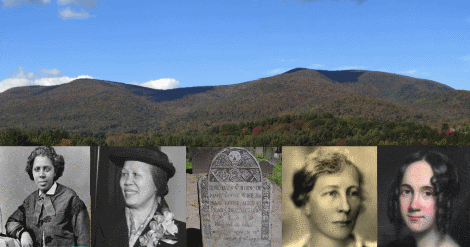
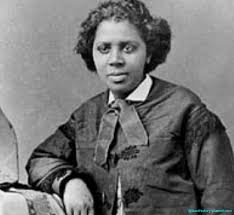
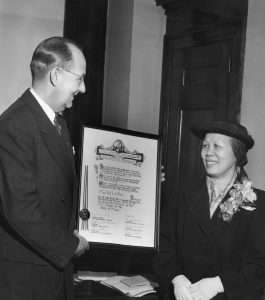
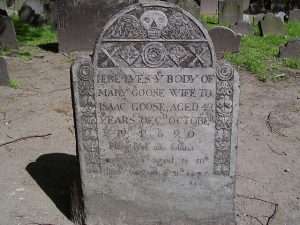

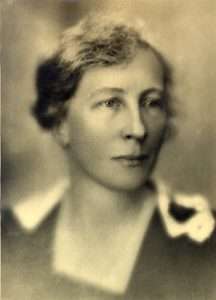

3 comments
Your image of Sarah Boone is sculptor Edmonia Lewis
The World’s Colombian Exposition (not exhibition) took place in Chicago in 1893, not 1876.
[…] her husband Frank died of a heart attack at the age of 42, Lillian Gilbreth turned her attention to the domestic space, where she sought to reduce the drudgery of household […]
Comments are closed.